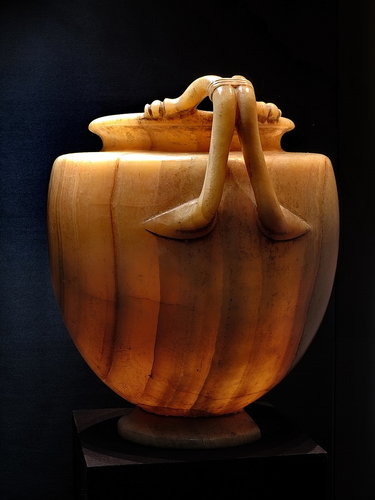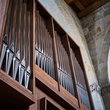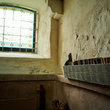For where your treasure is, there will your heart be also.
The term "treasure" is associated with different things. If one thinks of objects, then golden candlesticks, rings, jewellery, coins and the like quickly come to mind.
In an ecclesiastical treasury, however, one finds other things as well. If you look around the room, you will discover boxes and other vessels, as well as books, crosses and other objects. Most of them are richly decorated and sparkle magnificently in their display cases.
The actual treasures in a cathedral treasury such as this one in Quedlinburg are mostly housed invisibly in the various vessels. In an ecclesiastical treasury we find vessels that contain or have contained relics. Relics are the remains of saints. These can be direct physical remains, such as bones, hair, teeth. They can also be items directly associated with the person considered holy, such as rings, pieces of clothing or equipment, or items attributed to the person. Thus, a rough distinction is made between body relics (parts of the body) and touch relics (objects that touched the holy person).
The idea behind this is that the active power of God was active in holy persons and that this is preserved in their physical remains even after death. If one touches such a relic, one also touches the active power of God. This was an incentive for many people to go on pilgrimage to the place of the relic or the effect of the saint.
Relics are one aspect of ecclesiastical treasures that lead to the collections in today's treasuries, because these relics were appropriately packaged. The idea behind this is that hardly anything can be good enough to wrap the sacred. So special fabrics were brought in, sometimes even silk from the Far East, to wrap the relics in. These cloth packages were then elaborately stuffed into larger vessels. Sometimes to display them directly and sometimes to hide them inside. The reliquary box or shrine was then used to store, transport and display the relics. These boxes were also presented on the altar on high feast days and carried around town in processions. A relic itself would be much too small to be seen in the procession - in this respect a magnificent vessel served for presentation. At the same time, it must always be remembered that the packaging must be appropriate to the contents - as a gift to be given to a loved one is neatly wrapped because it supports the gesture of giving. It shows dedication.
We also find such a form of devotion and presentation in the magnificent books of the cathedral treasury. A gospel book contains collections of the gospel texts. Gospel means message. The Christian message and thus Christian truth is contained in these books. The effort put into the production of these books further emphasized the importance of these texts, and the magnificent book covers added to the idea of better presenting the text and the book's owner.
The texts were carefully painted letter by letter, sometimes in golden ink, the writing material was parchment, i.e. animal skin, in addition there were often elaborate illuminations. All this also shows a reverence for the content. It can be compared to a love letter, where not only the message is important, but also the way it is conveyed to the recipient.
The Quedlinburg cathedral treasure became world famous not only because of its special preciousness but also because of a story of robbery and return. During the Second World War, the cathedral treasure was removed from the church and ultimately taken to a cave near the outskirts of Quedlinburg. At the place where it was kept, it was guarded by two guards who then placed it in the care of the first Allied troops to reach Quedlinburg - the US Army. An officer assigned to catalog the pieces sent twelve of the Quedlinburg treasure pieces by field mail to his native Texas. After decades, the officer died in the early 1980s and bequeathed the pieces. The heirs tried to sell the pieces. In 1989, the Samuhel Gospels appeared in the art trade, but a sale did not take place. It took several more years of negotiations and searching until the treasure could return to Quedlinburg at the end of 1993. Two pieces are still missing since then.







